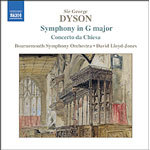
Dyson: Symphony in G Major / Concerto da Chiesa / At the Tabard Inn
 $25.00
Out of Stock
$25.00
Out of Stock2-4 weeks add to cart
GEORGE DYSON
Dyson: Symphony in G Major / Concerto da Chiesa / At the Tabard Inn
Duncan Riddell (violin) / Helen Cox (violin) / Stuart Green (viola) / Timothy Walden (cello) / Bournemouth Symphony Orchestra / David Lloyd-Jones, con
[ Naxos / CD ]
Release Date: Saturday 18 June 2005
This item is currently out of stock. We expect to be able to supply it to you within 2 - 4 weeks from when you place your order.
George Dyson was born in Halifax, West Yorkshire, the son of a blacksmith. Although from a working-class background in the industrial north, he became a Fellow of the Royal College of Organists at the age of sixteen. Winning an open scholarship to London's Royal College of Music in 1900 he went on to be the voice of public school music and, in 1937, Director of the Royal College of Music, the first alumnus of the College to do so, a fact of which he was inordinately proud. At the College Dyson was a pupil of Sir Charles Villiers Stanford, then at the height of his influence as a composition teacher. In 1904 Dyson won the Mendelssohn Scholarship, and went to Italy, later journeying on to Vienna and Berlin, where he met many of the leading musicians of the day. In London Nikisch conducted his early tone-poem Siena, later withdrawn.
On Dyson's return to England, Sir Hubert Parry recommended him as Director of Music at the Royal Naval College, Osborne. Dyson soon moved to Marlborough College, but on the outbreak of war in 1914 he enlisted. During the war he became celebrated for his training pamphlet on grenade warfare, which he produced as brigade grenadier officer of the 99th Infantry Brigade, and which was widely disseminated. Dyson saw action in the trenches and in due course was invalided out. In his diary Parry writes in shocked terms when he saw Dyson back in College, a shadow of his former self.
Dyson worked in the Air Ministry where he helped establish RAF bands, and he also realised the march RAF March Past that Walford Davies had sketched in short score. In 1920 he became known as a composer when his Three Rhapsodies for string quartet, composed soon after his return from the continent before the war, were chosen for publication under the Carnegie United Kingdom Trust's publication scheme. He was appointed to Wellington College, and he also became a professor at the Royal College Music.
In 1924 Dyson moved to Winchester College, where he enjoyed possibly the most productive part of his life as a composer. In addition to teaching and school music, here he also conducted an adult choral society. If one said that at this time he composed as a hobby one would give the wrong impression, yet this was a spare time activity for him in a busy professional musical life. Such practical musicianship gave him the foundation for his later successes. This started in 1928 with In Honour of the City, which was so successful he soon produced a more ambitious piece, The Canterbury Pilgrims, a succession of evocative and colourful Chaucerian portraits written for Winchester in 1931 and probably his most famous score. Soon he was commissioned by the Three Choirs Festivals to write further works, and for Hereford in 1933 he produced St Paul's Voyage to Melita (repeated in 1934, 1937 and 1952). Other Festivals soon followed, and The Blacksmiths was written for Leeds in 1934, and then Nebuchadnezzar for Worcester in 1935. There were also orchestral works including the Symphony in G of 1937 and in 1942 a Violin Concerto.
Knighted in 1941, Dyson retired in 1952, to enjoy a remarkable Indian summer of composition, though by this time his music was beginning to sound oldfashioned to some, and although it all achieved publication and performance it did not have quite the immediate following of his earlier scores. These later works included Sweet Thames Run Softly, a mellifluous setting for baritone, chorus and orchestra of words from Edmund Spenser's Prothalamion. Finally came a twenty-minute nativity sequence A Christmas Garland, and Agincourt a brilliant return to the scale and style of that first choral work, In Honour of the City, now setting well-known Shakespearean words.
- Lewis Foreman

